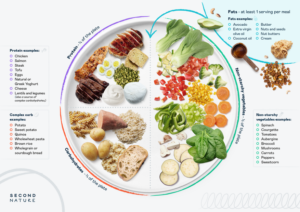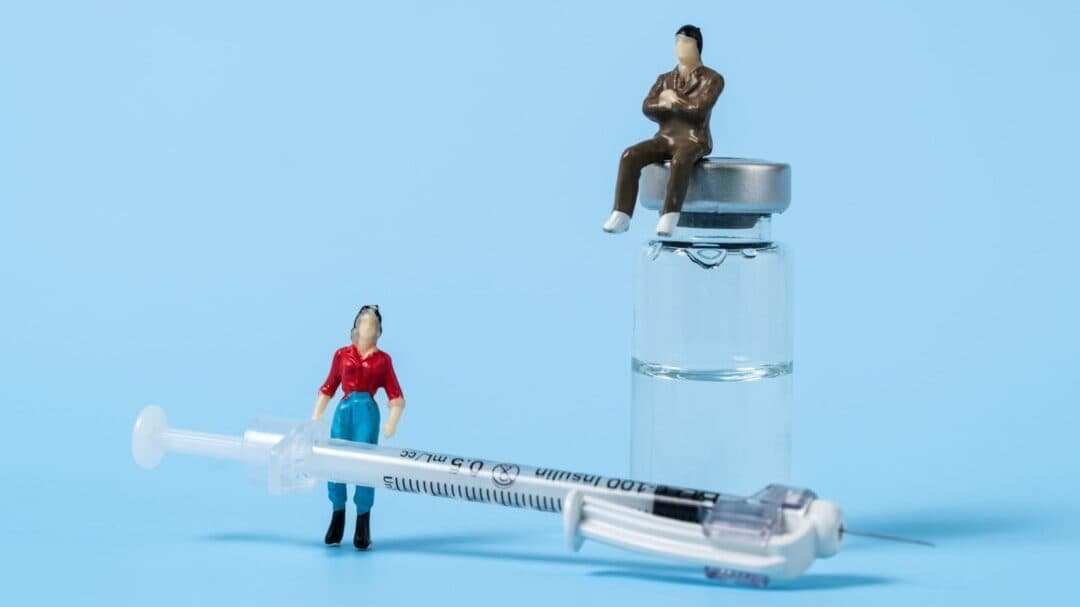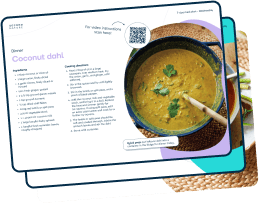Jump to: Four ways to improve insulin resistance | A lower-carb diet based on whole foods | Exercise | Stress management | Sleep | Take home message
Welcome to part four and the final article in our series on the personal fat threshold, insulin resistance, and type 2 diabetes.
In the first three articles of this series, we introduced the personal fat threshold hypothesis, the body’s essential energy systems regulating fat and carbohydrate, and how insulin resistance will influence your personal fat threshold.
If you haven’t read these articles yet, you can find them here:
- What’s your personal fat threshold?
- Insulin and the personal fat threshold
- Insulin resistance and the personal fat threshold
The critical message so far has been that the body’s ability to store fat in the form of subcutaneous fat (the fat beneath your skin) in the adipose tissue is a protective mechanism. It protects the vital organs from having to store fat and enables them to maintain normal function.
Underlying the function of our energy systems and vital organs is insulin. Insulin plays a key role in storing and burning energy efficiently.
When our body becomes insulin resistant, our ability to regulate energy is significantly reduced, meaning our chances of reaching our fat threshold and developing type 2 diabetes increase.
Fortunately, there are four ways we can improve our insulin resistance and lower our risk of, or manage, type 2 diabetes:
- A lower-carb diet based on whole foods.
- Exercise.
- Stress.
- Sleep.
At Second Nature, we’ve developed a programme specifically designed to reduce insulin resistance and your risk of developing type 2 diabetes.
In our first pilot study with NHS Portsmouth CCG, 40% of individuals living with type 2 diabetes reduced their blood sugar levels to the normal range, and people lost over 9% of their body weight on average.
If you’re currently living with type 2 diabetes and would like to join the Second Nature programme to see if you can lower your blood sugar levels, improve your health, and reduce your reliance on medications, you have two options:
- Speak to your GP to see whether Second Nature is available in your area and whether they can refer you to the programme.
- Click here to take our health quiz and join over 150,000 people who’ve improved their health through Second Nature.
Otherwise, keep reading as we analyse the primary lifestyle habits and practical tips you can introduce to improve insulin resistance, stay within your personal fat threshold, and lower your risk of type 2 diabetes.
Medication-assisted weight loss with a future focus
Start with Wegovy or Mounjaro, transition to habit-based health with our support


1) A lower-carb diet based on whole foods
We discussed in part two of this series that the two main factors influencing excess fat storage are our energy intake and our insulin levels.
In today’s modern environment, ultra-processed foods such as cereals, supermarket bread, cakes, biscuits, and crisps are not only energy-dense, but they also cause large insulin spikes due to their high content of refined carbohydrates and sugar.
Over time, this prevents our body from burning excess fat, which means we may reach our personal fat threshold more quickly because our adipose tissue struggles to continue to grow new fat cells or expand existing ones.
A lower-carb diet based on whole foods vegetables, meat, fish, dairy, nuts, legumes, and whole grains naturally increases your protein and healthy fat intake.
Protein and fat are digested more slowly than carbohydrates, providing a more stable energy release throughout the day. In addition, the insulin response to these nutrients is also much lower than the insulin response to carbohydrates.
This means your adipose tissue will be ‘mobilising’ more fat to be used for energy rather than consistently being forced to store it.
It also means you won’t max out your glycogen stores, ensuring that when you do consume carbohydrates, your body will have a place to store them for later use.
And while any diet rich in whole foods is likely to improve insulin resistance, human trials have suggested an advantage for diets higher in fat and protein and lower in carbohydrates.
A randomised controlled trial compared the impact of a Mediterranean, low-fat, and lower-carbohydrate diet on individuals living with insulin resistance.
Participants in the lower-carbohydrate and Mediterranean groups saw significant improvements in markers of insulin resistance after 24 months. In contrast, only modest improvements were observed in the low-fat group.
These observations are supported by a recent meta-analysis that suggests diets lower in carbohydrates and higher in fat and protein, such as lower carb and the Mediterranean diet, are more effective at improving insulin resistance and lowering blood sugar levels.
Click here for an NHS-trusted meal plan.

Key points:
- Ultra-processed foods lead to excess fat storage by both increasing circulating insulin levels and contributing to excess energy intake.
- A lower-carb diet based on whole foods provides a more stable energy release throughout the day and won’t cause the same insulin response you’d experience with ultra-processed foods.
- While any diet rich in whole foods will improve insulin resistance, research suggests diets rich in healthy fat and protein and lower in carbohydrates are more effective.
2) Exercise
One of the best ways to improve insulin resistance and lower your blood sugar levels is exercise. Below, we’ve highlighted the key reasons exercise improves insulin resistance and provided recommendations on what to do.
Strength training and high-intensity exercise
Strength and high-intensity training support our body’s energy systems in the following ways:
- Increases the volume of glucose moved from the bloodstream into the cells to be used for energy.
- Increases the volume of glucose that’s moved into the cells to be stored as glycogen.
- It improves insulin sensitivity, meaning that insulin can function more effectively.
- If you increase your muscle mass through training, you can also increase the glycogen stored in your muscles. More muscle = more glycogen capacity = less excess glucose stored as fat or leftover in the bloodstream.
- Increases the body’s ability to burn glucose as a fuel source outside of exercise, lowering blood sugar levels over time.
Some great options for this type of training are:
- HIIT
- CrossFit
- Circuit training
- Interval training
- Weight lifting
- Resistance bands
- Bodyweight workouts
Click here for our guide on how to exercise at home.
Aerobic training
This type of training has a whole wealth of benefits associated with it, including specific adaptations to your body that improve the function of your energy systems:
- Increases the volume of fat that’s burnt for energy.
- Like strength training, it increases the volume of glucose that’s moved into the cells to be stored as glycogen.
- It improves insulin sensitivity, meaning that insulin can function more effectively.
- It increases your cells’ ability to burn more energy by increasing the number of mitochondria (where your cells burn energy) in your cells.
- Increases the body’s ability to burn fat as a fuel source.
Some great options for this type of training are:
- Jogging
- Hiking
- Cycling
- Swimming
- Rowing
- Walking
- Why not join a local club? Social exercise is a great way to make it stick.
Key points:
- Both strength training, high-intensity exercise, and aerobic training improve the body’s energy systems but through different pathways.
- Strength training and high-intensity exercise predominantly require glucose for fuel and improve the body’s glucose regulation to a higher degree than aerobic training.
- Aerobic training improves the body’s ability to burn fat and improves the body’s regulation of fat to a higher degree than strength and intensity exercise.
- Both forms of training improve energy regulation and reduce insulin resistance.
3) Stress management
There are many ways in which chronic stress can harm our body’s energy systems and increase insulin resistance. Still, one of the primary issues appears to be the increase in the stress hormone cortisol.
Cortisol is released during stress to increase glucose release into the bloodstream from the liver. This ensures that your body has enough fast fuel available during stress, such as pressing the brake in your car if you see an animal on the road or running away from a threat.
But if you’re constantly in a state of sleep deprivation or stress, your body releases high amounts of glucose into the bloodstream. You’ll also be releasing higher levels of insulin, which can worsen insulin resistance over time.
Fortunately, there are some proven ways to reduce your circulating levels of cortisol and reduce stress:
1) Low-intensity exercise
While higher-intensity exercise can be a great tool, it increases cortisol levels in your bloodstream in the short term. This isn’t an issue for an individual with normal lower cortisol levels, as they will return to baseline after the exercise.
However, if you’re experiencing chronically high levels of cortisol due to stress or lack of sleep, you might want to avoid adding additional stressors to your lifestyle.
On the other hand, lower-intensity exercise has been shown to reduce cortisol levels. Some great options are:
- Walking
- Yoga, pilates, tai-chi
- Low-intensity cycling
- Low-intensity swimming (breaststroke)
- Any exercise you can do at a lower intensity
2) Meditate
Mindfulness meditation is the art of paying attention on purpose and without judgement. This typically involves sitting still with your eyes closed and focusing on your breath.
Research on meditation has expanded in the last 10-15 years, with multiple studies showing positive effects on mental health conditions, cognition, and brain structure.
Unsurprisingly, one area of focus has been the connection between meditation and stress. A study investigated the impact of 18 sessions of meditation on hair cortisol levels in young students compared to a control group with no intervention.
The results showed that hair cortisol levels dropped by 10%, while they rose in the control group. Similar results have been replicated in a study using blood cortisol levels in students in Thailand, which showed a 19.6% reduction after a meditation intervention of four hours a day for four days.
How can I get into a meditation habit?
Thanks to the introduction of popular apps and videos on YouTube, meditation has never been so accessible. Here are three great apps you can download today to help guide you through your meditation practice and help you turn it into a habit:
- Balance (currently offering a 1-year free subscription)
- Headspace
- Calm
3) Access nature
A review of 43 observational studies investigating the impact of spending time outdoors found strong associations between outdoor activities – particularly those with green space – such as gardening, nature viewing, and exercising with lower self-reported stress and blood cortisol levels.
This was supported by a study that measured the hair cortisol levels in 85 individuals and tracked their behaviours for 6-months to see what impact those activities would have on their cortisol levels.
The study found a strong correlation between the amount of time spent in nature and hair cortisol levels. So the more time the participants spent in nature, the lower their cortisol levels.
Spending time outdoors, in green spaces, and in natural environments seems to reduce cortisol levels and improve our health.
Key points:
- Stress can contribute to the development of insulin resistance through high cortisol levels.
- High cortisol levels lead to high glucose levels, which promote more insulin release in the blood.
- Low-intensity exercise, meditation, and accessing nature are three evidence-based ways to effectively lower cortisol levels.
4) Sleep
There are many areas where sleep deprivation can lead to insulin resistance. Like chronic stress, one of the key mechanisms seems to be the higher cortisol levels the body releases during sleep deprivation.
Here are three key areas to improve your sleep:
- Have a consistent sleep routine.
- Avoid technology before bedtime.
- Be mindful of your caffeine intake.
1) Have a consistent sleep routine
Your body’s cells are all aligned to an internal 24-hour clock known as the circadian rhythm. This has been developed across our evolution and was designed to ensure survival.
Research on maternal mothers supports this. A recent study randomised 123 mothers with 3-18-month-old children to a specific bedtime or no routine (control). The results showed that the mothers reported higher quality sleep, fewer awakenings during the night, and improved mood.
Here are three tips to ensure a regular bedtime routine:
- Set a regular bedtime and stick to it: Many smartphones will have a sleep function set up with a reminder to head to bed. Halfway through a film? Pause and return to it the next night – it’s not going anywhere.
- Set a regular alarm for the morning: As much as it’s essential to go to bed at the same time each night, it’s also important to stick to your morning routine. At first, you might feel tired when you wake up, but as your body adjusts to your routine, you’ll start to wake up naturally, and the alarm will act as a backup.
- Exercise and get outside during the day: Our circadian rhythm responds to daily time cues known as ‘Zeitgebers’ which provide feedback to the body’s cells on what time of day it is. Exercise is a strong Zeitgeber and can help your body’s hormonal balance to help a healthy sleep routine. Accessing the outdoors and exposing yourself to natural light in the morning seems to be a potent Zeitgeber and may help to boost your energy levels for the day.
2) Avoid technology half an hour to an hour before bedtime
There are two key reasons why avoiding technology before bedtime can be an effective strategy for improving sleep:
Blue light has been shown to disrupt sleep physiology.
Stimulating activities such as email and social media before bedtime have also been shown to interrupt sleep quality and duration.
A cross-sectional study investigated the link between electronic screen use before bedtime and sleep quality and duration. The results indicated that the more time spent on electronic screens before bedtime, the poorer the sleep quality and the lower the sleep duration. This association was more robust if the individuals were on social media or surfing the internet.
Recent research suggests that the impact of technology use on sleep has to do with a disruption in sleep physiology and the release of essential hormones that regulate our sleep-wake cycle, such as melatonin.
Because of the potential impact of technology use on our sleep quality, we recommend trying some of the following habits before bed:
- Reading
- Journalling
- Meditation
3) Be mindful of your caffeine intake
Caffeine is a natural stimulant that activates our central nervous system to improve mental performance and increase alertness. This is why you often feel that ‘boost’ or caffeine ‘buzz’ after your morning coffee.
Caffeine can impact our sleep by temporarily blocking the adenosine receptors in our brain (adenosine is the hormone responsible for helping us fall asleep), which results in us remaining alert and having difficulty falling asleep.
The relationship between coffee and caffeine consumption on sleep has been demonstrated in a recent systematic review which analysed 58 studies investigating the effects of caffeine on sleep.
The studies consistently showed altered sleep quality with higher caffeine intake. Although, it’s noteworthy that individual responses to caffeine will vary greatly.
Because of the effects of caffeine on sleep, we recommend:
- Avoiding caffeine after midday as it can stay in your system for up to 12 hours.
- Try switching to herbal teas or decaf in the afternoon.
Key points:
- A lack of sleep impacts insulin resistance in many ways; one of those is the increase in cortisol levels.
- Having a consistent sleep routine, avoiding technology before bed, and avoiding caffeine after midday are three evidence-based ways to improve your sleep.
Take home message
The personal fat threshold can be described as the tipping point at which your body can no longer store fat in the adipose tissue as subcutaneous fat.
At this point, more fat will be stored in your vital organs, such as your liver or your pancreas, and chronic diseases such as type 2 diabetes will develop or accelerate.
Your body’s energy systems which govern how and where your food energy is stored are primarily influenced by your lifestyle and your level of insulin resistance.
All lifestyle areas can impact your body’s ability to regulate food energy. It’s not just about diet and exercise but also sleep, stress, and relaxation.
Hopefully, throughout this series, you’ve developed a greater understanding of how your body functions and the lifestyle strategies you can implement to improve your health for the long term.


